MITSUBISHI GRANDIS 2010 (in English) Workshop Manual
Manufacturer: MITSUBISHI, Model Year: 2010, Model line: GRANDIS, Model: MITSUBISHI GRANDIS 2010Pages: 273, PDF Size: 21.01 MB
Page 51 of 273
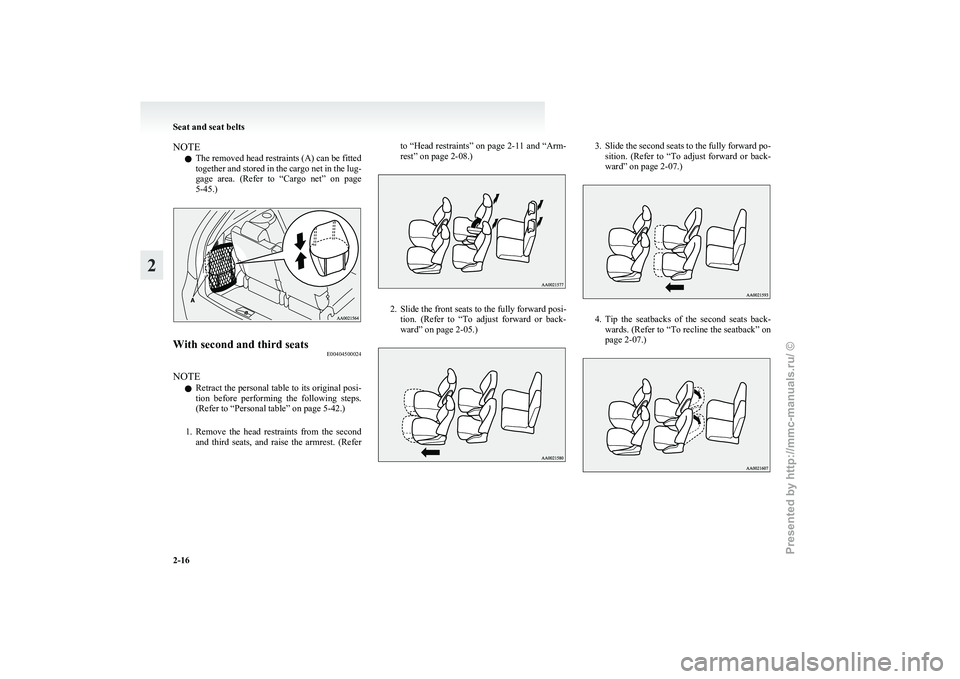
NOTE
l The removed head restraints (A) can be fitted
together
and stored in the cargo net in the lug-
gage area. (Refer to “Cargo net” on page
5-45.) With second and third seats
E00404500024
NOTE l Retract
the personal table to its original posi-
tion before performing the following steps.
(Refer to “Personal table” on page 5-42.)
1. Remove the head restraints from the second and third seats, and raise the armrest. (Refer to “Head
restraints” on page 2-11 and “Arm-
rest” on page 2-08.)
2. Slide the front seats to the fully forward posi-
tion.
(Refer to “To adjust forward or back-
ward” on page 2-05.) 3. Slide
the second seats to the fully forward po-
sition. (Refer to “To adjust forward or back-
ward” on page 2-07.) 4. Tip
the seatbacks of the second seats back-
wards. (Refer to “To recline the seatback” on
page 2-07.) Seat and seat belts
2-16
2
Presented by http://mmc-manuals.ru/ \251
Page 52 of 273
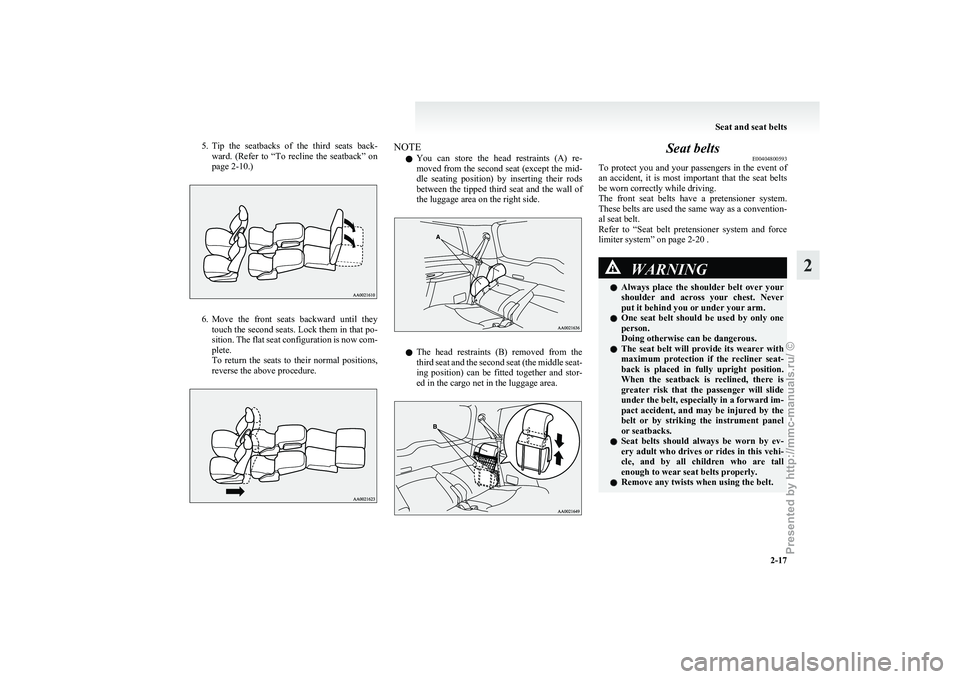
5. Tip the seatbacks of the third seats back-
ward. (Refer to “To recline the seatback” on
page 2-10.) 6. Move
the front seats backward until they
touch the second seats. Lock them in that po-
sition. The flat seat configuration is now com-
plete.
To return the seats to their normal positions,
reverse the above procedure. NOTE
l You
can store the head restraints (A) re-
moved from the second seat (except the mid-
dle seating position) by inserting their rods
between the tipped third seat and the wall of
the luggage area on the right side. l
The
head restraints (B) removed from the
third seat and the second seat (the middle seat-
ing position) can be fitted together and stor-
ed in the cargo net in the luggage area. Seat belts
E00404800593
To
protect you and your passengers in the event of
an accident, it is most important that the seat belts
be worn correctly while driving.
The front seat belts have a pretensioner system.
These belts are used the same way as a convention-
al seat belt.
Refer to “Seat belt pretensioner system and force
limiter system” on page 2-20 . WARNING
l Always
place the shoulder belt over your
shoulder and across your chest. Never
put it behind you or under your arm.
l One seat belt should be used by only one
person.
Doing otherwise can be dangerous.
l The seat belt will provide its wearer with
maximum protection if the recliner seat-
back is placed in fully upright position.
When the seatback is reclined, there is
greater risk that the passenger will slide
under the belt, especially in a forward im-
pact accident, and may be injured by the
belt or by striking the instrument panel
or seatbacks.
l Seat belts should always be worn by ev-
ery adult who drives or rides in this vehi-
cle, and by all children who are tall
enough to wear seat belts properly.
l Remove any twists when using the belt. Seat and seat belts
2-17 2
Presented by http://mmc-manuals.ru/ \251
Page 53 of 273
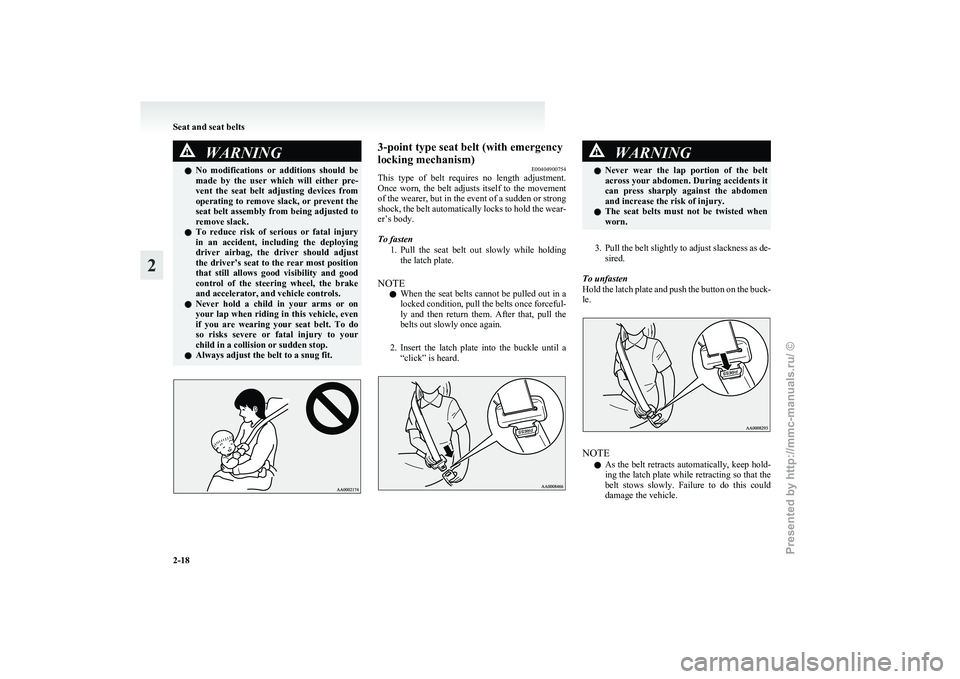
WARNING
l No modifications or additions should be
made by the user which will either pre-
vent the seat belt adjusting devices from
operating to remove slack, or prevent the
seat belt assembly from being adjusted to
remove slack.
l To reduce risk of serious or fatal injury
in an accident, including the deploying
driver airbag, the driver should adjust
the driver’s seat to the rear most position
that still allows good visibility and good
control of the steering wheel, the brake
and accelerator, and vehicle controls.
l Never hold a child in your arms or on
your lap when riding in this vehicle, even
if you are wearing your seat belt. To do
so risks severe or fatal injury to your
child in a collision or sudden stop.
l Always adjust the belt to a snug fit. 3-point type seat belt (with emergency
locking mechanism)
E00404900754
This
type of belt requires no length adjustment.
Once worn, the belt adjusts itself to the movement
of the wearer, but in the event of a sudden or strong
shock, the belt automatically locks to hold the wear-
er’s body.
To fasten
1. Pull the seat belt out slowly while holdingthe latch plate.
NOTE l When the seat belts cannot be pulled out in a
locked condition, pull the belts once forceful-
ly and then return them. After that, pull the
belts out slowly once again.
2. Insert the latch plate into the buckle until a “click” is heard. WARNING
l Never
wear the lap portion of the belt
across your abdomen. During accidents it
can press sharply against the abdomen
and increase the risk of injury.
l The seat belts must not be twisted when
worn.
3. Pull
the belt slightly to adjust slackness as de- sired.
To unfasten
Hold the latch plate and push the button on the buck-
le. NOTE
l As
the belt retracts automatically, keep hold-
ing the latch plate while retracting so that the
belt stows slowly. Failure to do this could
damage the vehicle. Seat and seat belts
2-18
2
Presented by http://mmc-manuals.ru/ \251
Page 54 of 273
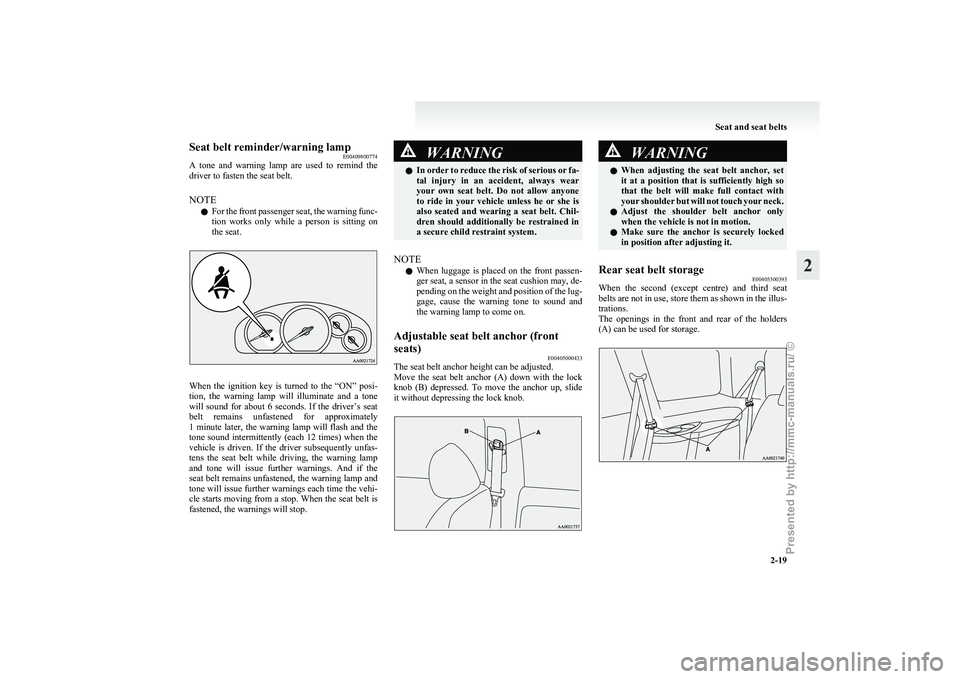
Seat belt reminder/warning lamp
E00409800774
A
tone and warning lamp are used to remind the
driver to fasten the seat belt.
NOTE
l For the front passenger seat, the warning func-
tion works only while a person is sitting on
the seat. When the ignition key is turned to the “ON” posi-
tion,
the warning lamp will illuminate and a tone
will sound for about 6 seconds. If the driver’s seat
belt remains unfastened for approximately
1 minute later, the warning lamp will flash and the
tone sound intermittently (each 12 times) when the
vehicle is driven. If the driver subsequently unfas-
tens the seat belt while driving, the warning lamp
and tone will issue further warnings. And if the
seat belt remains unfastened, the warning lamp and
tone will issue further warnings each time the vehi-
cle starts moving from a stop. When the seat belt is
fastened, the warnings will stop. WARNING
l In
order to reduce the risk of serious or fa-
tal injury in an accident, always wear
your own seat belt. Do not allow anyone
to ride in your vehicle unless he or she is
also seated and wearing a seat belt. Chil-
dren should additionally be restrained in
a secure child restraint system.
NOTE l When
luggage is placed on the front passen-
ger seat, a sensor in the seat cushion may, de-
pending on the weight and position of the lug-
gage, cause the warning tone to sound and
the warning lamp to come on.
Adjustable seat belt anchor (front
seats) E00405000433
The seat belt anchor height can be adjusted.
Move
the seat belt anchor (A) down with the lock
knob (B) depressed. To move the anchor up, slide
it without depressing the lock knob. WARNING
l When
adjusting the seat belt anchor, set
it at a position that is sufficiently high so
that the belt will make full contact with
your shoulder but will not touch your neck.
l Adjust the shoulder belt anchor only
when the vehicle is not in motion.
l Make sure the anchor is securely locked
in position after adjusting it.
Rear seat belt storage E00405300393
When the second (except centre) and third seat
belts
are not in use, store them as shown in the illus-
trations.
The openings in the front and rear of the holders
(A) can be used for storage. Seat and seat belts
2-19 2
Presented by http://mmc-manuals.ru/ \251
Page 55 of 273
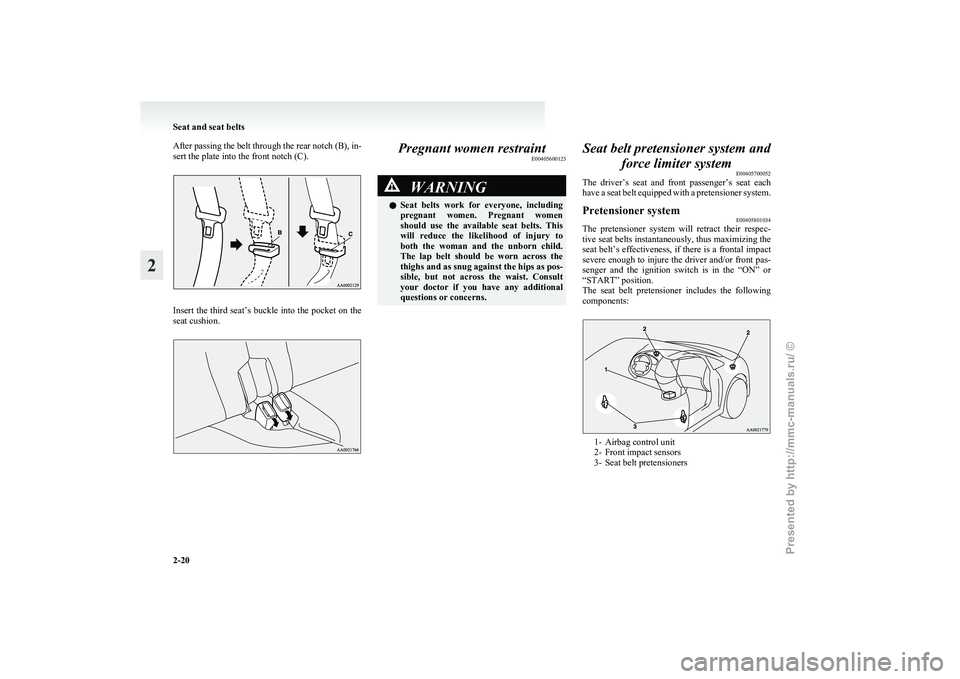
After passing the belt through the rear notch (B), in-
sert the plate into the front notch (C).
Insert the third seat’s buckle into the pocket on the
seat cushion. Pregnant women restraint
E00405600123 WARNING
l Seat belts work for everyone, including
pregnant women. Pregnant women
should use the available seat belts. This
will reduce the likelihood of injury to
both the woman and the unborn child.
The lap belt should be worn across the
thighs and as snug against the hips as pos-
sible, but not across the waist. Consult
your doctor if you have any additional
questions or concerns. Seat belt pretensioner system and
force limiter system E00405700052
The
driver’s seat and front passenger’s seat each
have a seat belt equipped with a pretensioner system.
Pretensioner system E00405801034
The pretensioner system will retract their respec-
tive
seat belts instantaneously, thus maximizing the
seat belt’s effectiveness, if there is a frontal impact
severe enough to injure the driver and/or front pas-
senger and the ignition switch is in the “ON” or
“START” position.
The seat belt pretensioner includes the following
components: 1- Airbag control unit
2-
Front impact sensors
3- Seat belt pretensioners Seat and seat belts
2-20
2
Presented by http://mmc-manuals.ru/ \251
Page 56 of 273
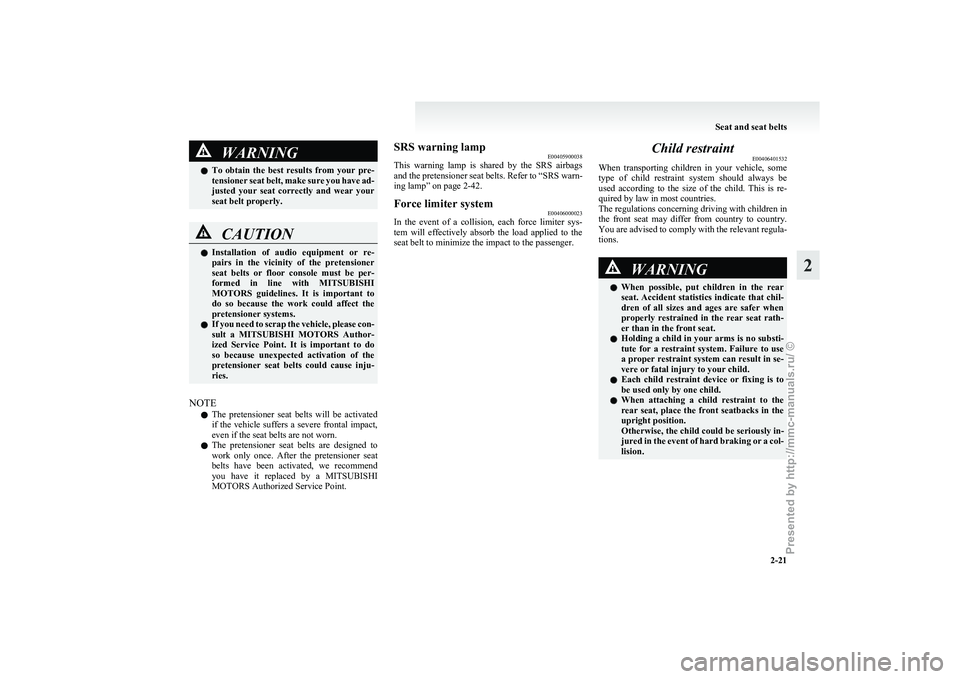
WARNING
l To obtain the best results from your pre-
tensioner seat belt, make sure you have ad-
justed your seat correctly and wear your
seat belt properly. CAUTION
l
Installation
of audio equipment or re-
pairs in the vicinity of the pretensioner
seat belts or floor console must be per-
formed in line with MITSUBISHI
MOTORS guidelines. It is important to
do so because the work could affect the
pretensioner systems.
l If you need to scrap the vehicle, please con-
sult a MITSUBISHI MOTORS Author-
ized Service Point. It is important to do
so because unexpected activation of the
pretensioner seat belts could cause inju-
ries.
NOTE l The
pretensioner seat belts will be activated
if the vehicle suffers a severe frontal impact,
even if the seat belts are not worn.
l The pretensioner seat belts are designed to
work only once. After the pretensioner seat
belts have been activated, we recommend
you have it replaced by a MITSUBISHI
MOTORS Authorized Service Point. SRS warning lamp
E00405900038
This
warning lamp is shared by the SRS airbags
and the pretensioner seat belts. Refer to “SRS warn-
ing lamp” on page 2-42.
Force limiter system E00406000023
In the event of a collision, each force limiter sys-
tem
will effectively absorb the load applied to the
seat belt to minimize the impact to the passenger. Child restraint
E00406401532
When
transporting children in your vehicle, some
type of child restraint system should always be
used according to the size of the child. This is re-
quired by law in most countries.
The regulations concerning driving with children in
the front seat may differ from country to country.
You are advised to comply with the relevant regula-
tions. WARNING
l When
possible, put children in the rear
seat. Accident statistics indicate that chil-
dren of all sizes and ages are safer when
properly restrained in the rear seat rath-
er than in the front seat.
l Holding a child in your arms is no substi-
tute for a restraint system. Failure to use
a proper restraint system can result in se-
vere or fatal injury to your child.
l Each child restraint device or fixing is to
be used only by one child.
l When attaching a child restraint to the
rear seat, place the front seatbacks in the
upright position.
Otherwise, the child could be seriously in-
jured in the event of hard braking or a col-
lision. Seat and seat belts
2-21 2
Presented by http://mmc-manuals.ru/ \251
Page 57 of 273
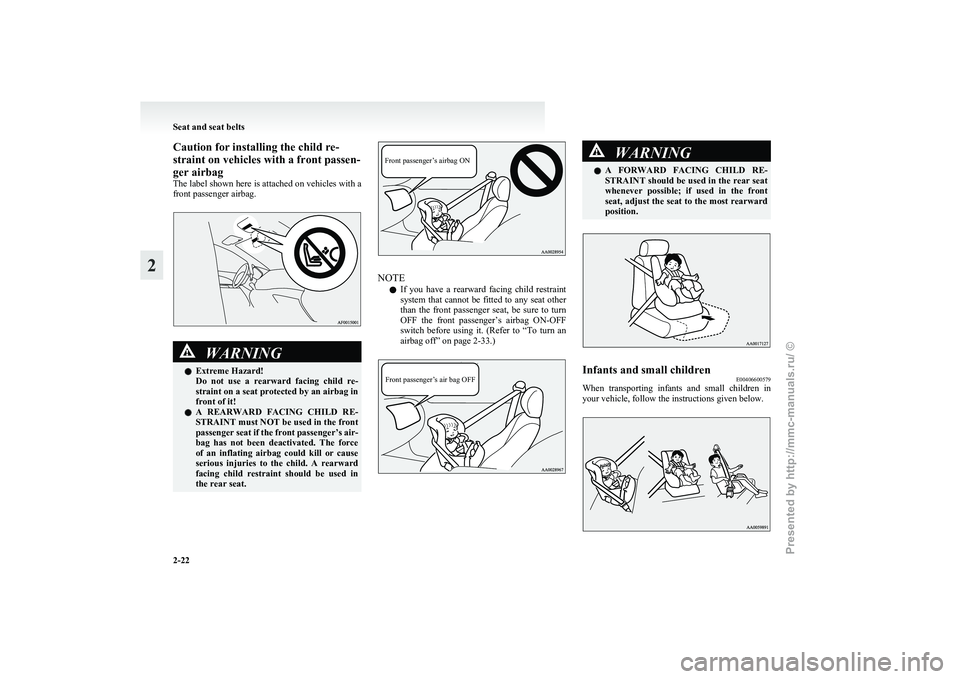
Caution for installing the child re-
straint on vehicles with a front passen-
ger airbag
The
label shown here is attached on vehicles with a
front passenger airbag. WARNING
l Extreme Hazard!
Do
not use a rearward facing child re-
straint on a seat protected by an airbag in
front of it!
l A REARWARD FACING CHILD RE-
STRAINT must NOT be used in the front
passenger seat if the front passenger’s air-
bag has not been deactivated. The force
of an inflating airbag could kill or cause
serious injuries to the child. A rearward
facing child restraint should be used in
the rear seat.
Front passenger’s airbag ON NOTE
l If
you have a rearward facing child restraint
system that cannot be fitted to any seat other
than the front passenger seat, be sure to turn
OFF the front passenger’s airbag ON-OFF
switch before using it. (Refer to “To turn an
airbag off” on page 2-33.)
Front passenger’s air bag OFF WARNING
l A
FORWARD FACING CHILD RE-
STRAINT should be used in the rear seat
whenever possible; if used in the front
seat, adjust the seat to the most rearward
position. Infants and small children
E00406600579
When transporting infants and small children in
your vehicle, follow the instructions given below. Seat and seat belts
2-22
2
Presented by http://mmc-manuals.ru/ \251
Page 58 of 273
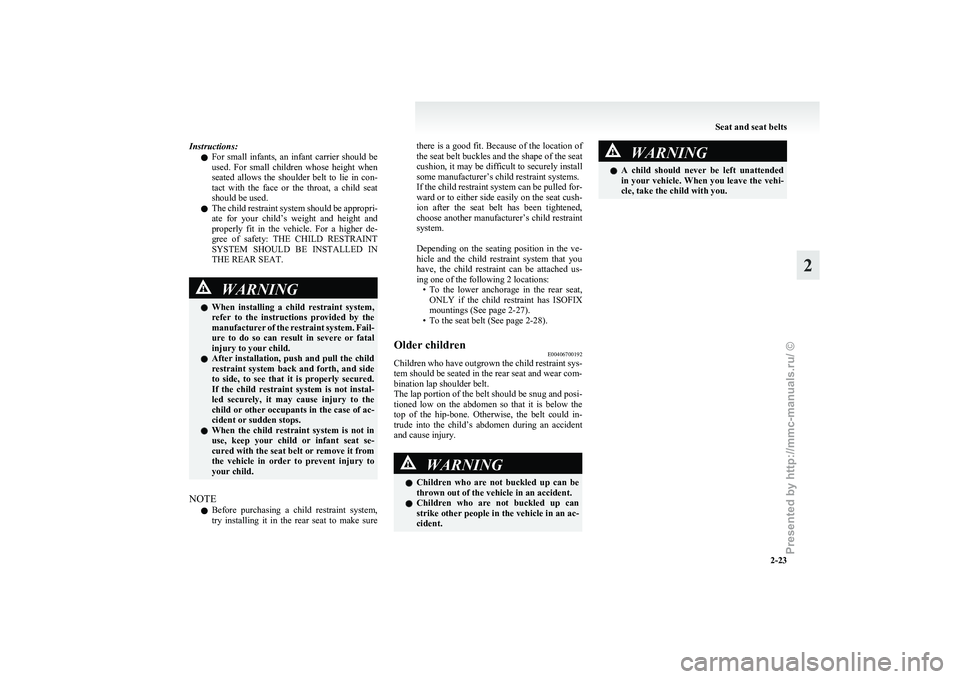
Instructions:
l For
small infants, an infant carrier should be
used. For small children whose height when
seated allows the shoulder belt to lie in con-
tact with the face or the throat, a child seat
should be used.
l The child restraint system should be appropri-
ate for your child’s weight and height and
properly fit in the vehicle. For a higher de-
gree of safety: THE CHILD RESTRAINT
SYSTEM SHOULD BE INSTALLED IN
THE REAR SEAT. WARNING
l When
installing a child restraint system,
refer to the instructions provided by the
manufacturer of the restraint system. Fail-
ure to do so can result in severe or fatal
injury to your child.
l After installation, push and pull the child
restraint system back and forth, and side
to side, to see that it is properly secured.
If the child restraint system is not instal-
led securely, it may cause injury to the
child or other occupants in the case of ac-
cident or sudden stops.
l When the child restraint system is not in
use, keep your child or infant seat se-
cured with the seat belt or remove it from
the vehicle in order to prevent injury to
your child.
NOTE l Before
purchasing a child restraint system,
try installing it in the rear seat to make sure there is a good fit. Because of the location of
the
seat belt buckles and the shape of the seat
cushion, it may be difficult to securely install
some manufacturer’s child restraint systems.
If the child restraint system can be pulled for-
ward or to either side easily on the seat cush-
ion after the seat belt has been tightened,
choose another manufacturer’s child restraint
system.
Depending on the seating position in the ve-
hicle and the child restraint system that you
have, the child restraint can be attached us-
ing one of the following 2 locations: • To the lower anchorage in the rear seat,ONLY if the child restraint has ISOFIX
mountings (See page 2-27).
• To the seat belt (See page 2-28).
Older children E00406700192
Children who have outgrown the child restraint sys-
tem should be seated in the rear seat and wear com-
bination lap shoulder belt.
The lap portion of the belt should be snug and posi-
tioned
low on the abdomen so that it is below the
top of the hip-bone. Otherwise, the belt could in-
trude into the child’s abdomen during an accident
and cause injury. WARNING
l Children
who are not buckled up can be
thrown out of the vehicle in an accident.
l Children who are not buckled up can
strike other people in the vehicle in an ac-
cident. WARNING
l A
child should never be left unattended
in your vehicle. When you leave the vehi-
cle, take the child with you. Seat and seat belts
2-23 2
Presented by http://mmc-manuals.ru/ \251
Page 59 of 273
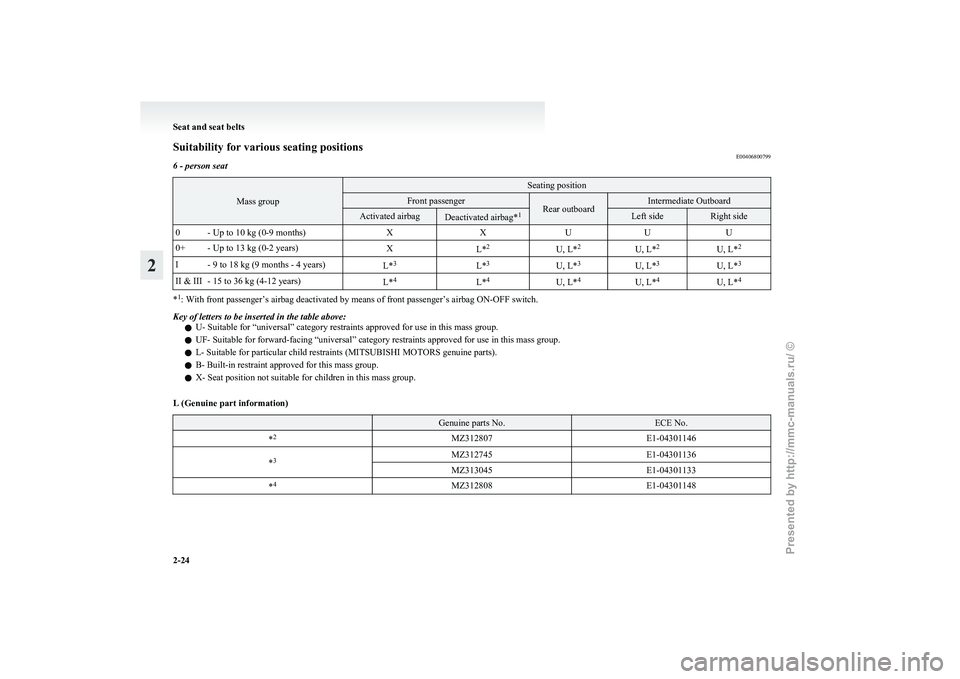
Suitability for various seating positions
E00406800799
6 - person seat Mass group Seating position
Front passenger
Rear outboard Intermediate Outboard
Activated airbag
Deactivated airbag*
1 Left side Right side
0 - Up to 10 kg (0-9 months) XXUU U
0+ - Up to 13 kg (0-2 years) XL*2
U, L*2
U, L*2
U, L*2
I - 9 to 18 kg (9 months - 4 years) L*3
L*3
U, L*3
U, L*3
U, L*3
II & III - 15 to 36 kg (4-12 years) L*4
L*4
U, L*4
U, L*4
U, L*4 *
1
: With front passenger’s airbag deactivated by means of front passenger’s airbag ON-OFF switch.
Key of letters to be inserted in the table above: l U- Suitable for “universal” category restraints approved for use in this mass group.
l UF- Suitable for forward-facing “universal” category restraints approved for use in this mass group.
l L- Suitable for particular child restraints (
MITSUBISHI MOTORS genuine parts).
l B- Built-in restraint approved for this mass group.
l X- Seat position not suitable for children in this mass group.
L (Genuine part information) Genuine parts No. ECE No.
* 2
MZ312807 E1-04301146
* 3 MZ312745
E1-04301136
MZ313045 E1-04301133
* 4
MZ312808 E1-04301148Seat and seat belts
2-24
2
Presented by http://mmc-manuals.ru/ \251
Page 60 of 273
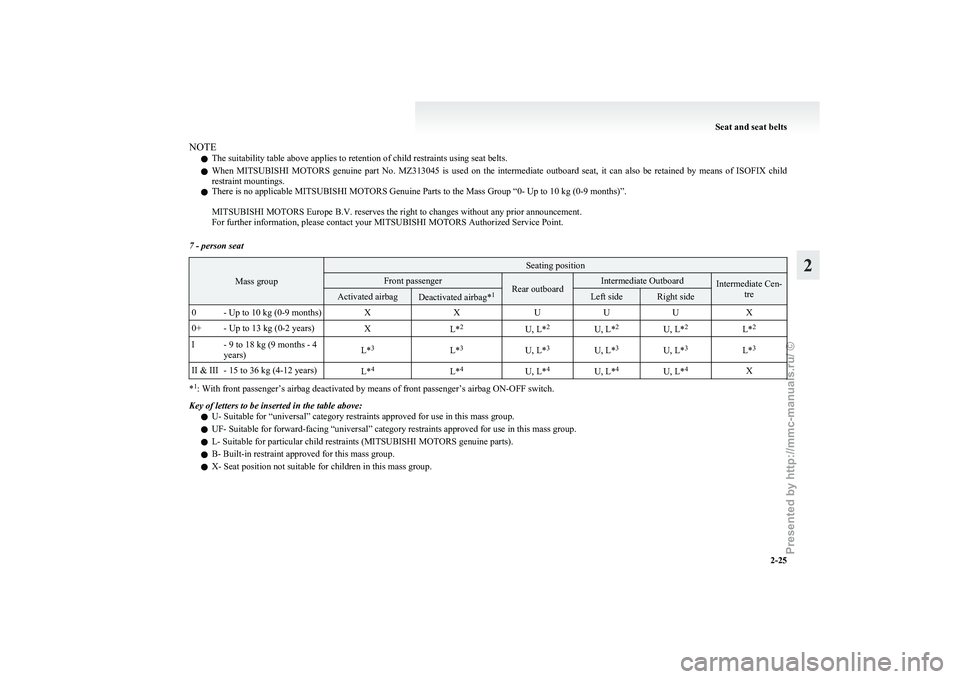
NOTE
l The suitability table above applies to retention of child restraints using seat belts.
l When MITSUBISHI MOTORS
genuine part No. MZ313045 is used on the intermediate outboard seat, it can also be retained by means of ISOFIX child
restraint mountings.
l There is no applicable MITSUBISHI MOTORS Genuine Parts to the Mass Group “0- Up to 10 kg (0-9 months)”.
MITSUBISHI MOTORS Europe B.V. reserves the right to changes without any prior announcement.
For further information, please contact your MITSUBISHI MOTORS Authorized Service Point.
7 - person seat Mass group Seating position
Front passenger
Rear outboard Intermediate Outboard
Intermediate Cen-
tre Activated airbag
Deactivated airbag*
1 Left side Right side
0 - Up to 10 kg
(0-9 months) X XUUU X
0+ - Up to 13 kg (0-2 years) XL*2
U, L*2
U, L*2
U, L*2
L*2
I - 9 to 18 kg (9 months - 4 years) L*
3
L*3
U, L*3
U, L*3
U, L*3
L*3
II & III - 15 to 36 kg (4-12 years) L*4
L*4
U, L*4
U, L*4
U, L*4
X*
1
: With front passenger’s airbag deactivated by means of front passenger’s airbag
ON-OFF switch.
Key of letters to be inserted in the table above: l U- Suitable for “universal” category restraints approved for use in this mass group.
l UF- Suitable for forward-facing “universal” category restraints approved for use in this mass group.
l L- Suitable for particular child restraints (
MITSUBISHI MOTORS genuine parts).
l B- Built-in restraint approved for this mass group.
l X- Seat position not suitable for children in this mass group. Seat and seat belts
2-25 2
Presented by http://mmc-manuals.ru/ \251